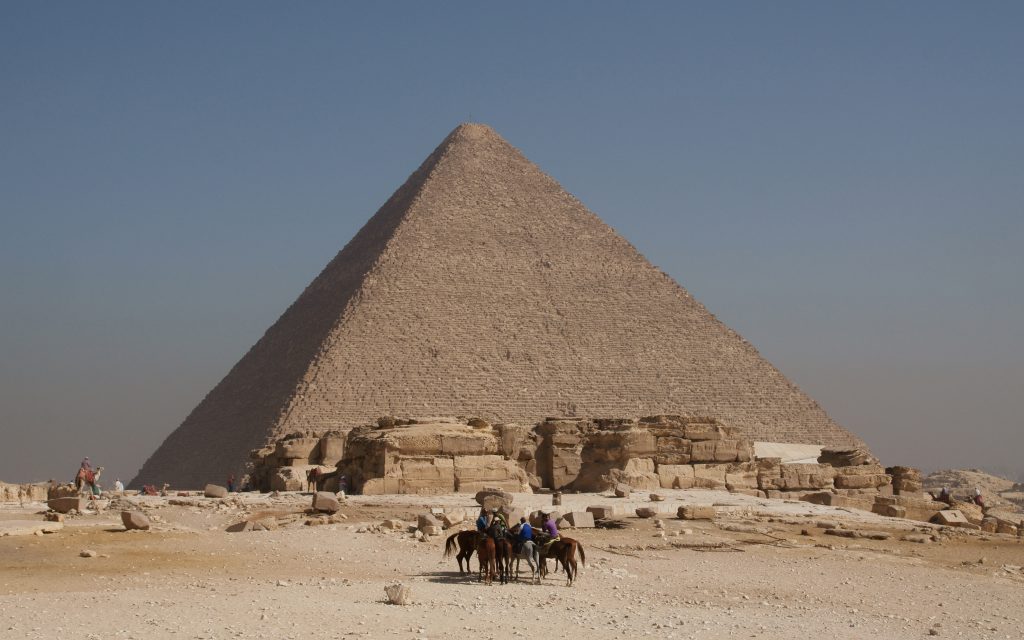The construction of the Great Pyramid of Giza has been a great mystery for many centuries. Recently, archaeologists believe that they have found evidence that suggests that it was not slaves, under the order of King Khufu, who were responsible for building the pyramid. With the discovery of nearby mastabas, there is now substantial evidence suggesting that normal villagers would periodically help construct the Great Pyramid, and they were motivated by their religious beliefs.1
King Khufu is considered one of the greatest rulers of his time, largely due to the elaborate pyramid he was able to create during his lifetime. He was known as a cruel and tyrannical leader, but was evidently powerful by being able to gather a large workforce and enough materials to construct the Great Pyramid, most of which is still intact today. According to Greek historian Herodotus, there had been around one hundred thousand slaves working through King Khufu’s reign. This was proved false in 1990 when the archaeologist Zahi Hawass discovered a town of mastabas near Giza.

These mastabas were rectangular mounds made of mud bricks. Eventually, they would stack some of them together to form pyramids, giving them the idea of the modern pyramid. The findings of many mastabas suggests that the workers were not slaves but were actually compensated in some form for their labor. They also discovered two miniature pyramids that held the remains of officials, such as supervisors, technicians, and craftsmen on the upper level, and other laborers on the lower level.2 The workforce consisted mainly of peasant farmers who would work during the fall and winter seasons. During that time period they were unable to work on their farms due to the seasonal overflow of the Nile River. This gave them an opportunity to continue working throughout the year. It was also a great way for the peasant farmers to get food, clothing, and shelter.3 Some laborers took part in a group called a phyle, which was a rotating group of workers who would work for a month. The king would collect surplus crops as well as other clothing to distribute to these workers, which he levied as a form of tax. Egyptologist such as Zahi Hawass and Mark Lehner now estimate that only about twenty to thirty thousand men were needed to build the Great Pyramid.
The construction of the pyramid was a communal project in which all Egyptians took part, including women as well as men. At the time, there were no machines or animals to help carry the loads of limestone and granite to the pyramids.4 Every block was handmade and crafted to fit perfectly alongside the other pieces. They cared greatly in their work and took pride in their accomplishments. Not only were they building the burial site for their king, but they were also taking part in the construction of a new and elaborate Egypt.
During Egypt’s Old Kingdom, when these pyramids were built, the kings were associated religiously to gods. They were seen as the living manifestation of the god Horus, the god of the sky. The god Horus was also the son of Osiris, who was the king of the underworld. Once the king would pass away he would become one with Horus.5 This helped motivate the laborers to continue building the pyramids. Most Egyptians at that time were very religious and spent their life preparing for what would come after death. They believed that by building the pyramid for their king, a descendant of Osiris, they would assure both their king and themselves a good afterlife. Because of this, they did not see their work as a continuous strain, but rather viewed it as an honor.
Overall, it was a very organized and coherent system that allowed everyone to partake in. It was beneficial not only to King Khufu, but to the entire Egyptian society as well. Jobs were created and many peasants received benefits of clothing and shelter from the enterprise. It united the Egyptian civilization and created magnificent pyramids that we can still visit today.
- Mastabas are burial mounds that were used to bury rulers and pharaohs, which later gave way to the idea of a pyramid. See Global Events : Milestone Events throughout History, Vol 1. Africa, Jennifer Stock, ed. (Detroit : Gale, Cengage Learning, 2014., 2014), 12. ↵
- Global Events : Milestone Events throughout History, Vol 1. Africa, Jennifer Stock, ed. (Detroit : Gale, Cengage Learning, 2014., 2014), 18. ↵
- The Oxford Companion to Archaeology (2 ed.), 2012, s.v. “Pyramids of Giza,” by Edward Bleiberg. ↵
- The Oxford Companion to Archaeology (2 ed.), 2012, s.v. “Pyramids of Giza,” by Edward Bleiberg. ↵
- Funk & Wagnalls New World Encyclopedia, 2016, s.v. “Horus”. ↵



87 comments
Bryan Martin Patino
this article is really interesting, it is surprising learning that the Egyptians were gladly working on the giant pyramids on their own accord. Its hard to under stand how dedicated they were to their religion. The fear Egyptians carried for being deemed a bad person by their gods must have been pretty motivational to encourage them to build something so large on there free time. I wish i had the same dedication that the Egyptians had .
Samuel Ruiz
All of my life, I had always understood the Great Pyramid of Giza to have been built by slaves, but this article gave me a whole new look on the subject. It was reassuring to read about the lives of the workers and their possibility of being compensated for their work. I found it even more surprising when Diana mentioned that all the Egyptians took part in the construction of the pyramid. It seems as if the workers wanted to build the pyramids and participate in the project, rather than simply being forced to do so.
Andrew Dominguez
When i think of the pyramids i think of a large force of slaves working to build them. Now finding out it was people who would volunteer is shocking. The time it had to take to carry those stones is incredible since people back than were smaller in size. What i want to know is how this building is still standing after the environment takes it toll on it. While building today, can be destroyed very easily.
Austin Pena
Great Article! Knowing that the Great Pyramids were constructed by the villagers makes the site even more astonishing. These people took great pride in constructing this monument that I would assume they hoped would last for generations and it did. Not only is it surprising how they constructed it, and all that had to be carved and moved, but that they did it purely for satisfaction is amazing. I’ve read other articles stating that a feat like this would be almost impossible into days age, but if that civilization was able to pull something like that off why are we still where we are? Maybe we’re to lazy or maybe we don’t have faith in ourselves, but we should and we should see this as motivation for us to create and do things that future generations will look back on and think “how did they manage to make this?”
Destiny Flores
The pyramids of Giza are mysterious in the idea that we will never know for sure the exact answers to why it was built? and who built it? It just makes me curious because I had read somewhere else that each of the ‘bricks’ that make up the pyramid weigh around 2.5 tons. Even if the people that built it weren’t slaves, how did they manage to move those blocks around, and even more so, align them perfectly where they would endure hundreds of years to come?
Iris Henderson
The Great Pyramids of Giza and their making have been portrayed for a long time as structures that were built by slaves. After reading this article I have learned not only that this common misconception isn’t true but that the creation of these monuments was something that the Egyptians took great pride and honor in. King Khufu used his power to create jobs and a system that benefitted all of Egypt.
Natalia Carroll-Long
This article is very insightful. I had no idea that the builders of the pyramid weren’t slaves, but instead were commons folk. I think that really show you how strong beliefs are. If I’m not wrong, the only place that they could’ve gotten the bricks from was miles away and would have to had been carried by foot. For the villagers to have made such a huge monument purely out of their belief astonishes me. This could also show when religion and politics go hand in hand how strong that government can be.
Samman Tyata
Well, I really liked you article. I have heard of the Great Pyramid of Giza before but your article has helped me to know more about it. This was a very well managed and informative article. You have done a great job by explaining the terms like mastabas. It was good to know that jobs were created and many peasants received benefits of clothing and shelter from the enterprise. To sum it up, it was a good read.
Cameron Ramirez
We read plenty of times in history class that slaves built the Great Pyramid of Giza and many other pyramids for their pharaohs. When I read your article, I was surprised to read that not only was it built by ordinary villagers but there were compensated for their working on the pyramids. I hope that one day I can visit Egypt and see these pyramids in real life. Overall, good work on your essay and the pictures you added helped grab the audience.
Oceane Roux
Thank you for this great article! Pyramids have always amazed me, and the way they were built is a huge mystery. Indeed, I heard that many people are starting to believe that aliens were at the origins of the Pyramids. While we still have no answer to this question, I find it very interesting that slaves did not build them but free men. This article is a good insight of the functioning and the organization of the creation of Pyramids.